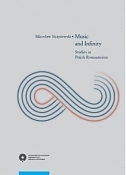|
||
• wydawnictwa polskie
• Zamów informacje o nowościach z wybranego tematu • kontakt
• Cookies na stronie |
MUSIC AND INFINITY STUDIES IN POLISH ROMANTICISMSTRZYŻEWSKI M.wydawnictwo: WYD UMK , rok wydania 2017, wydanie Icena netto: Music and InfinityStudies in Polish RomanticismThe rhythm of Romanticism in Poland is ominously tapped by history, politics, various defeats, and the sense of national captivity, but the descant to this main melodic line are rhythms and melodies of everyday life and extraordinary art. Contrary to many stereotypes and clichés referring to Polish Romanticism, national martyrology and historism are not the only matter of concern for Polish authors. Tradition, customs, everydayness, social relations, existence, and art are crucial literary themes. In addition, aesthetic experiences, the musical life, the search for sacrum in the individual dimension and outside the Catholic Church are typical of Romanticism in Poland, which brings this movement closer to the European culture of that period. All essays collected in this book are dedicated to these issues from the border of art, aesthetics, and specific mysticism. Introduction / 7 180 pages, Hardcover
Po otrzymaniu zamówienia poinformujemy, |


